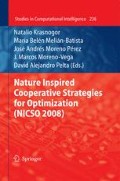Abstract
A metaheuristic called Sensitive Ant Model (SAM) for solving combinatorial optimization problems is developed. The proposed model is based on the Ant Colony System (ACS) algorithm in which agents cooperate indirectly using pheromone trails. SAM improves and extends the ACS approach by endowing each agent of the model with properties that induce heterogeneity. Different pheromone sensitivity levels are used for agents in the population. Highly-sensitive agents are essentially influenced in the decision making process by stigmergic information and thus likely to select strong pheromone-marked moves. Search intensification can be therefore sustained. Agents with low sensitivity are biased towards random search inducing diversity for exploration of the environment. A balanced sensitivity distribution is facilitated by the co-existence of several subpopulations with pheromone sensitivity level generated in a specified range. A heterogeneous agent model has the potential to cope with complex search spaces. Sensitive agents (or ants) allow many types of reactions to a changing environment facilitating an efficient balance between exploration and exploitation.
Access this chapter
Tax calculation will be finalised at checkout
Purchases are for personal use only
Preview
Unable to display preview. Download preview PDF.
References
Chira, C., Dumitrescu, D., Pintea, C.-M.: Heterogeneous Sensitive Ant Model for Combinatorial Optimization. In: Genetic and Evolutionary Computation Conference GECCO 2008, Atlanta, Georgia, USA, July 12-16, 2008, pp. 163–164. ACM, New York (2008)
Chira, C., Dumitrescu, D., Pintea, C.-M.: Sensitive Ant Model for Combinatorial Optimization. In: Radomil, M. (ed.) 14th International Conference in Soft Computing MENDEL, Brno University of Technology (2008)
Crainic, T.G., Toulouse, M.: Parallel Strategies for Metaheuristics. In: Glover, F., Kochenberger, G. (eds.) Handbook of Metaheuristics, pp. 475–513. Kluwer Academic Publishers, Dordrecht (2002)
Dorigo, M., Gambardella, L.M.: Ant Colony System: A cooperative learning approach to the traveling salesman problem. IEEE Trans. on Systems Man and Cybernetics 26, 29–41 (1996)
Dorigo, M., Stützle, T.: The Ant Colony Optimization Metaheuristic: Algorithms, Applications and Advances. In: Handbook of Metaheuristics (2002)
Grassé, P.P.: La Reconstruction du nid et les Coordinations Inter-Individuelles chez Bellicositermes Natalensis et Cubitermes sp. La theorie de la Stigmergie: Essai d’interpretation du Comportement des Termites Constructeurs. Insectes Sociaux 6, 41–81 (1959)
Helsgaun, K.: An effective implementation of the linkernighan TSP heuristic. European J. of Oper. Res. 126, 106–130 (2000)
Kaveh, A., Shahrouzi, M.: A hybrid ant strategy and genetic algorithm to tune the population size for efficient structural optimization. Engineering Computations 24(3), 237–254 (2007)
Nakamichi, Y., Arita, T.: Diversity control in ant colony optimization. Artificial Life and Robotics, Springer Japan 7(4), 198–204 (2004)
Stützle, T., Hoos, H.H.: Max-Min Ant System. Future Generation Comp Systems 16(9), 889–914 (2000)
http://www.iwr.uni-heidelberg.de/groups/comopt/software/TSPLIB95/
http://iridia.ulb.ac.be/~mdorigo/ACO/aco-code/public-software.html
Author information
Authors and Affiliations
Editor information
Editors and Affiliations
Rights and permissions
Copyright information
© 2009 Springer-Verlag Berlin Heidelberg
About this chapter
Cite this chapter
Pintea, C.M., Chira, C., Dumitrescu, D. (2009). Sensitive Ants: Inducing Diversity in the Colony. In: Krasnogor, N., Melián-Batista, M.B., Pérez, J.A.M., Moreno-Vega, J.M., Pelta, D.A. (eds) Nature Inspired Cooperative Strategies for Optimization (NICSO 2008). Studies in Computational Intelligence, vol 236. Springer, Berlin, Heidelberg. https://doi.org/10.1007/978-3-642-03211-0_2
Download citation
DOI: https://doi.org/10.1007/978-3-642-03211-0_2
Publisher Name: Springer, Berlin, Heidelberg
Print ISBN: 978-3-642-03210-3
Online ISBN: 978-3-642-03211-0
eBook Packages: EngineeringEngineering (R0)

